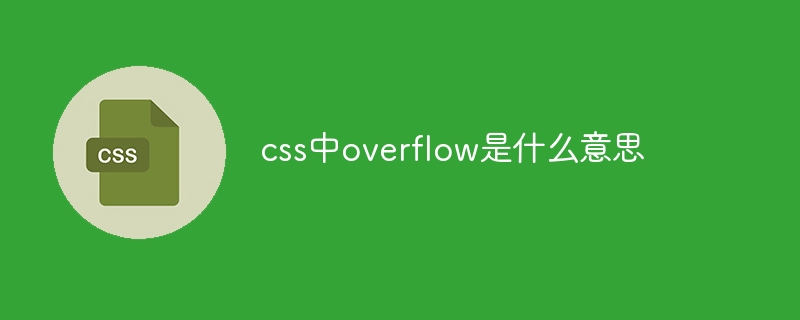What does overflow mean in css
The Overflow property in CSS controls the display mode of element content that exceeds the boundary: visible: The content is visible when it exceeds the boundary. hidden: Hide anything beyond the bounds. scroll: Any content beyond the bounds is visible and scroll bars appear. auto: A scroll bar appears when the content exceeds the bounds, otherwise the content is hidden. initial: Use the browser's default overflow value.

Overflow
The overflow property in CSS controls how an element's content is displayed when it exceeds its boundaries. It has many values that can produce different effects.
Possible Overflow values and effects:
- visible: Visible when content exceeds the bounds.
- hidden: Any content beyond the boundaries will be hidden.
- scroll: Any content beyond the bounds will be visible, and scroll bars will appear to allow the user to view hidden sections.
- auto: If the content exceeds the bounds, a scroll bar will appear, otherwise the content will be hidden.
- initial: Use the browser's default overflow value.
How to use Overflow:
The overflow attribute should be applied to elements where you wish to control content beyond the bounds. For example, the following CSS will hide the content of a div element that exceeds its container:
div {
overflow: hidden;
}If you want to allow the user to scroll the content of a div element that exceeds its bounds, you can use the following CSS:
div {
overflow: scroll;
}When to use Overflow:
The overflow attribute is very useful when controlling the content of an element that exceeds the bounds. It prevents content from overflowing and breaking the layout of the web page. It also improves the user experience by providing scrolling functionality when needed.
The above is the detailed content of What does overflow mean in css. For more information, please follow other related articles on the PHP Chinese website!

Hot AI Tools

Undresser.AI Undress
AI-powered app for creating realistic nude photos

AI Clothes Remover
Online AI tool for removing clothes from photos.

Undress AI Tool
Undress images for free

Clothoff.io
AI clothes remover

AI Hentai Generator
Generate AI Hentai for free.

Hot Article

Hot Tools

Notepad++7.3.1
Easy-to-use and free code editor

SublimeText3 Chinese version
Chinese version, very easy to use

Zend Studio 13.0.1
Powerful PHP integrated development environment

Dreamweaver CS6
Visual web development tools

SublimeText3 Mac version
God-level code editing software (SublimeText3)

Hot Topics
 How to draw a specific shape with an orange background color using CSS' clip-path property?
Apr 05, 2025 pm 04:36 PM
How to draw a specific shape with an orange background color using CSS' clip-path property?
Apr 05, 2025 pm 04:36 PM
Practical application cases of CSS drawing function In modern web design, CSS can not only be used for layout and style, but also for creating complex graphics and animations. May...
 How to add loading animation to the a tag click and then jump?
Apr 05, 2025 pm 04:48 PM
How to add loading animation to the a tag click and then jump?
Apr 05, 2025 pm 04:48 PM
Cleverly implementing the short animation and jump after clicking the a tag, many times, we hope that after clicking the a tag, the page can first display a short loading event...
 What are the encoded fonts used in the picture? How to apply this font style in a project?
Apr 05, 2025 pm 05:06 PM
What are the encoded fonts used in the picture? How to apply this font style in a project?
Apr 05, 2025 pm 05:06 PM
Introduction and use of encoded fonts In programming and web design, choosing the right font can greatly improve the readability and aesthetics of the code. recent,...
 How to elegantly achieve high adaptability of the middle content in the three-line layout?
Apr 05, 2025 pm 04:39 PM
How to elegantly achieve high adaptability of the middle content in the three-line layout?
Apr 05, 2025 pm 04:39 PM
Discussion on the height of adaptive intermediate content in three-line layout In web layout, you often encounter the need to implement three-line layout and the intermediate content is highly variable...
 What is the
What is the What are the elements in CSS for? During the learning and using CSS, you may encounter some less common HTML elements, such as <...
 How to use locally installed 'Jingnanmai Round' on a web page without loading the font file?
Apr 05, 2025 pm 04:54 PM
How to use locally installed 'Jingnanmai Round' on a web page without loading the font file?
Apr 05, 2025 pm 04:54 PM
How to use locally installed font files on web pages In web page development, sometimes we will encounter the situation where we need to use specific fonts installed on our computer...
 How to customize the hover effect of merge rows in el-table?
Apr 05, 2025 pm 06:54 PM
How to customize the hover effect of merge rows in el-table?
Apr 05, 2025 pm 06:54 PM
How to customize the hover effect of merge rows in el-table? Using Element...
 How to increase the height of the input while keeping the text at the bottom?
Apr 05, 2025 pm 05:09 PM
How to increase the height of the input while keeping the text at the bottom?
Apr 05, 2025 pm 05:09 PM
How to increase the height of the input while keeping the text at the bottom? In web development, sometimes we need to set an input box with a larger height...






